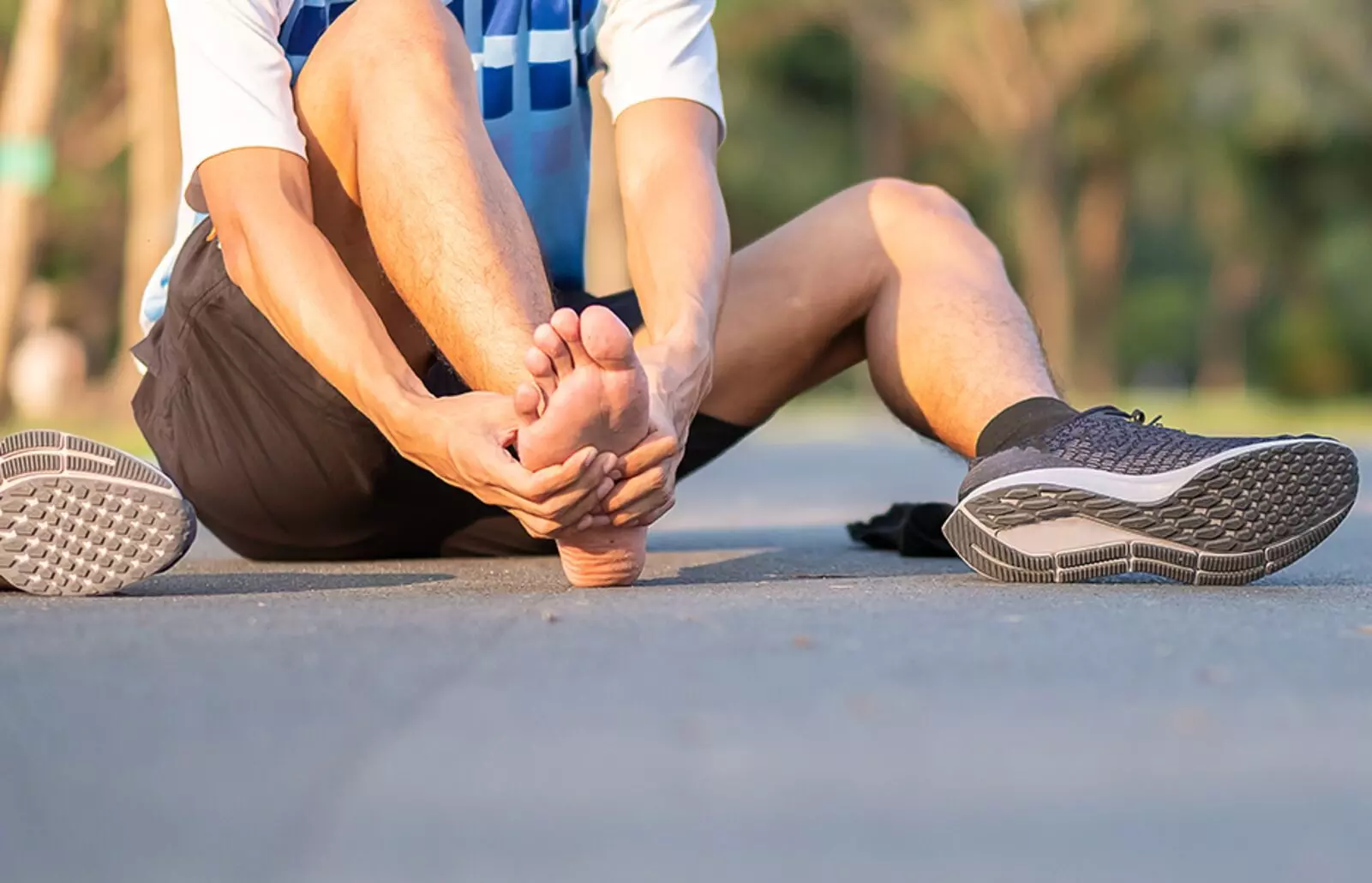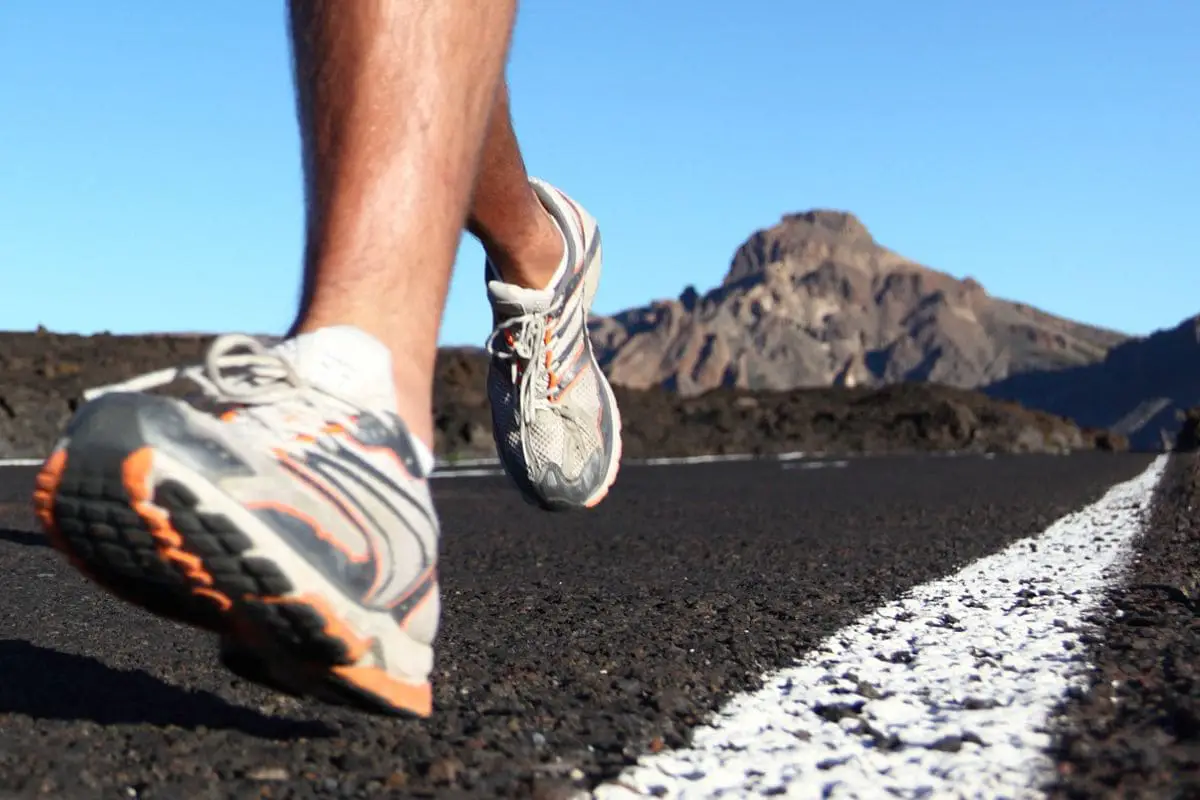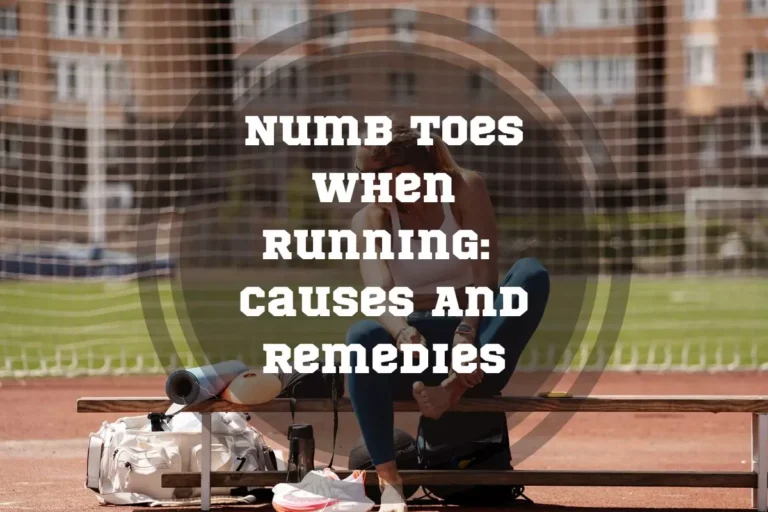Ball of Foot Pain When Running: 3 Causes + 5 Best Solutions
Reviewed by: Ernesto Mendez (Orthopedic Clinical Specialist)
Are you an avid runner who suffers from ball of foot pain? This is a common complaint amongst runners, and can be caused by strain and overuse due to activities such as excessive running or walking.
In this blog post, we’ll look at the causes, symptoms, and treatment options for pain in ball of foot when running. Don’t let foot pain stop you from hitting the track. Read on to find out how you can reduce your discomfort and get back to doing what you love!
There are many causes of ball of foot pain when running, but you can prevent and reduce it following a few tips, including rest, massage, stretching, foot support gear, and strengthening exercises. In severe cases, you may need to seek medical support to reduce inflammation.
Pain in the Ball of the Foot While Running
Pain in ball of foot after running and during runs is a common disorder known by several names, including metatarsalgia. This injury commonly affects runners and others who engage in high-impact activities that place extra pressure on their feet.
Pain may begin suddenly or because of an accumulation of weaknesses built up over time. It often feels like sharp pain when pushing off with each stride while running. Runners are prone to this condition when they increase intensity too quickly without taking enough rest between workouts. This leads to weakening of supportive muscles, making them painful for long periods after challenging physical loads during running activities.
3 Causes of Pain in the Ball of the Foot While Running
There are a number of different causes of running ball of foot pain. Let’s take a closer look at three of them.
1. Soft Tissue Injuries
Soft tissue injuries such as strains, tendonitis, and bursitis are common causes of ball of foot pain experienced by runners. These injuries can be caused by overuse or overextension, as well as excessive running or walking on hard surfaces.
When a strain occurs in the soft tissues around the foot, it often leads to inflammation and pain in the ball of the foot, which can worsen with activity.
2. Bone Injuries
Bone injuries are an often-overlooked cause of pain in the ball of the foot while running. Common issues include stress reactions and stress fractures that can be caused by overuse or repetitive impacts.
Stress reactions occur as bones attempt to heal themselves and may involve soreness, swelling, tenderness in the ball of the foot, and difficulty bearing weight.
Under a high degree of force, these stress reactions can progress into bone fractures, such as a navicular fracture (which involves an injury to the small navigation bone on top of the midfoot) or a metatarsal fracture involving one of five long bones extending from your toes to your ankle.
3. Irritation or Inflammation
Inflammation and irritation can occur in the ball of the foot as a result of overuse or overextension. Pain will normally feel sharp and burning around your toes, heel, or arch when putting pressure on them.
It may also spread across the entire bottom part of your feet when running for long distances. In some cases, you may experience numbness or pain that worsens with activity. Gait abnormalities such as flat feet may also be associated with this type of pain and discomfort while running, due to improper shock absorption.
3 Symptoms of Pain in the Ball of the Foot for Runner’s
Common symptoms of this condition include pain, tenderness, and swelling in the ball of the foot, along with difficulty bearing weight and pain that worsens with activity. Let’s discuss them in more detail.
1. Tenderness or Swelling
Tenderness and swelling in the ball of the foot can occur as a result of prolonged running activities or due to poor footwear support. When the bones, muscles, and other tissues around the ball of the foot are put under strain from too much pressure or stress, it can cause discomfort.
Irritation and inflammation are also another common culprit that leads to pain in this area when running for long periods of time. Painful symptoms, such as sharp increases, dull aching at night time, and feeling as if there’s something pressing underneath your sole during physical activity may indicate metatarsalgia.
2. Pain That Worsens with Activity
Pain in the ball of the foot that worsens with running is a type of metatarsalgia, which is characterized by a sharp, aching, or burning pain in the area. Running causes increased strain on the bones and soft tissue of the forefoot due to constant impacts with each step. This repetitive stress can cause inflammation of underlying tissues around the toes or joints in the region, leading to increased pain when running.
3. Difficulty Bearing Weight
Difficulty bearing weight is a common symptom of ball of foot pain in runners. A decrease in the foot’s normal capacity to endure pressure can cause stabbing or burning sensations when bearing weight. When it happens while running, it can significantly worsen performance, as even slight discomfort can lead to increased fatigue and impair pace and motivation.
Additionally, having difficulty bearing weight can increase the risk of developing further issues, like plantar fasciitis or Achilles tendonitis, due to biomechanical changes associated with compensatory gait patterns in response to the initial injury.
What To Do If You Have Ball of Foot Pain During or After Running: 5 Solutions
The following are some tips to help you get rid of ball of foot sore after running. However, if the pain persists after trying home remedies, it’s best to consult a doctor for proper treatment.

1. Proper Footwear and Cushioning
When running, wearing the right pair of shoes with cushioning and arch support can make a world of difference in helping to reduce ball of foot pain. Cushion-soled shoes provide additional shock absorption when you land on your feet and absorb energy away rather than bouncing it back up into your feet, relieving pressure and stress.
Arch supports serve as a buffer against impacts on hard surfaces while providing increased stability for more comfortable strides during long runs or races. A proper fit is also essential, as ill-fitting athletic shoes may cause problems such as blisters or joint pain.
Pro Tip:
Additionally, soaking your feet post-run in cold water for 10 minutes can help ease stiffness and decrease inflammation following an especially strenuous session.
2. Stretching and Strengthening Exercises
Stretching and strengthening exercises are an important part of treating and preventing ball of the feet pain while running.
This is usually done with calf stretches or plantar fascia-specific stretches like toe curls, which involves pushing down on each toe individually with your finger tips. Exercises such as heel raises can help to strengthen and support both ankles and arches.
Pro Tip:
Rolling a golf ball under your feet for several minutes can help relieve aches and pains that result from running long distances.
3. RICE
RICE is an acronym that stands for Rest, Ice, Compression, and Elevation, which can be combined to form a simple yet effective self-care technique for managing foot pain during or after running.
Resting the foot helps protect it from further injury by avoiding activities that may irritate the condition. Applying ice to the affected area helps reduce swelling and relieve pain.
Compression bandages can provide support and reduce swelling in the feet. Lastly, elevating your feet above heart level promotes proper circulation, which reduces swelling.
Subscribe to Our Running Newsletter!
Get free running tips from renowned professional athletes and discounts from top-notch brands.
4. Orthotic Inserts or Arch Supports
Orthotics are a great way to alleviate foot pain for runners. Orthotic inserts, in particular, are shoe inserts that help the entire body by providing cushioning and arch support to minimize stress on the balls of the feet.
The extra cushioning relieves pressure from walking or running, while also stabilizing your foot, adding support, and reducing joint strain. Furthermore, metatarsal pads (increased forefoot cushioning) can help relieve painful sensations and inflammation caused by metatarsalgia.
5. Physical Therapy or Massage
Physical therapy and massage are often recommended to runners suffering from ball of foot pain when running. Physical therapy exercises help by improving flexibility, strengthening the muscles in the foot, reducing inflammation, and promoting the healing of soft tissue injuries.
Common physical therapy exercises include calf muscle stretches, gluteal strength training, and foam rolling. Massage is also beneficial, as it targets tightness and trigger points in the feet that can cause pain while running.
Pro Tip:
Techniques such as cross-friction massage and deep tissue kneading can increase blood flow and alleviate discomfort caused by tight muscles or fascia restriction. They make tense muscles more relaxed, thereby increasing performance and decreasing the risk of further injury.
6 Tips to Prevent Ball of Foot Pain After or When Running
By taking preventative measures, you may be able to reduce the risk of ball of foot pain. Here are six tips to consider:
1. Consider Using Orthotics
If you’re a runner struggling with ball of foot pain, orthotics may be your answer. Orthotics are custom-made inserts that provide support and cushioning to the arch and heel of the foot, relieving pressure on the painful area in your foot while running.
These inserts come in various styles, including full-length and 3/4 leather and foam styles. Footbeds can be heat molded to fit better into the shoe, allowing for better control when walking or running.
2. Use Socks with Proper Cushioning
If your ball of foot hurt after running, consider using socks with proper cushioning. Cushioned socks will provide extra support and comfort, which is essential for maintaining healthy feet and preventing further injury, such as metatarsalgia.
By wearing cushioned materials underneath your feet, you can lessen the impact of each step taken, reducing the strain on the balls of your feet.

3. Strengthen the Muscles in Your Feet
Strengthening the muscles is an important step for runners to ensure their feet are well taken care of and reduce the risk of metatarsalgia or any other related foot problems.
Exercises such as toe gripping, ankle rotations, towel scrunches, calf raises, and rocker board exercises are effective ways to strengthen the muscles located in your feet.
4. Stretch Regularly
Stretching is essential for runners, as it increases flexibility, reduces muscle tightness, and prevents injuries. Regular stretching helps keep the muscles in your feet tuned up while running.
Additionally, regular stretching helps optimize balance strength and improves tendon/muscle suppleness, leading to better posture while walking or running.
5. Choose Softer Surfaces for Running
Running on softer surfaces can help ease metatarsalgia running and reduce the strain and impact on your feet, ankles, and lower body. Soft surfaces like grass, dirt trails, and synthetic tracks provide cushioning to minimize shock from the ground up through your feet and into the rest of your body. This can reduce the risk of pain in your ball of foot, as well as other injuries, such as plantar fasciitis and runner’s toe.
Avoid uneven surfaces and those with small stones that could cause tripping accidents or unexpected foot placement problems, which will increase pressure at one spot, potentially leading to ball of foot pain after you finish running.
6. Wear Properly Fitting Running Shoes
When running, you need to wear shoes that fit correctly and provide good support. Properly fitting running shoes should embrace the heel, mid-foot, and toe area of your feet. This helps reduce pressure on the bones in the forefoot and can prevent injuries like stress fractures.
Supportive cushioning also provides better shock absorption while running because it distributes weight evenly across your foot. This helps you avoid overuse pain and irritation in a particular part of your foot.
5 Tips to Choose the Right Shoes for Running If You Have Ball of Foot Pain
When selecting ball of foot pain shoes, be sure to check the cushioning and shock absorption levels, arch support stability, toe box width and flexibility, and heel-to-toe drop for a proper fit.
1. Cushioning and Shock Absorption
The right shoes can reduce pressure, soreness, inflammation, and discomfort in the ball of the foot caused by intense exercise.
Pro Tip:
Good cushioning should be able to absorb up to 40% of force when running or jumping, whereas foam soles typically absorb 20-30% of force upon affect meaning less strain on your feet.
Furthermore, having an advanced cushioning system like air pockets under the foot also helps improve reactivity while running, which increases overall performance.
2. Arch Support and Stability
Arch support plays an essential role in minimizing foot pain for runners. It helps to provide cushioning and shock absorption, while also controlling pronation to help prevent injury.
Stability sneakers with built-in arch supports are particularly beneficial for runners who experience ball of foot pain, as they can be customized to provide additional support when needed. This can go a long way in reducing stress on the joints and muscles and decreasing foot discomfort during running or other activities that involve repetitive motion, such as walking or jumping.
3. Toe Box Width and Flexibility
When it comes to managing ball of foot pain while running, having proper toe box width and flexibility in your running shoes is essential. Toe box designs that are too narrow can cause pressure on the metatarsal bones, resulting in pinched nerves, swelling, and discomfort.
Running shoes with a slightly wider toe-box give you adequate room for your toes to spread out naturally during physical activity, without feeling cramped or restricted.
Pro Tip:
Flexible materials such as synthetic mesh upper fabrics allow sufficient medial and lateral motion, but still provide enough support around the midfoot so that feet will not roll over during runs or strenuous activities.
4. Heel-to-Toe Drop
Heel-to-toe drop is an important consideration for runners looking to reduce strain on their feet and prevent ball of foot pain. This refers to the difference in height between the heel cushioning and forefoot cushioning of a running shoe. A higher drop directs more shock toward the lower leg, hips, and knees, while a lower drop provides more protection for the balls of your feet.
When selecting your pair of shoes for metatarsalgia, always make sure that they provide ample cushioning and support throughout your entire foot, from heel to toe.

5. Proper Fit and Comfort
When it comes to running, proper fit and comfort are of utmost importance for runners who experience pain in the balls of their feet. Wearing shoes that are too tight or that don’t offer enough cushioning can add pressure on the foot, leading to increased discomfort while running.
Frequently Asked Questions About Ball of Foot Pain When Running
How do you stop balls of feet from hurting when running?
Running with ball of foot pain can be frustrating and uncomfortable. The key to relieving this type of pain is finding the right shoes that offer proper cushioning and support for your running style, in addition to taking care of yourself with rest and self-care measures such as stretching and strengthening exercises.
Can I keep running with metatarsalgia?
It’s possible for runners with metatarsalgia to continue running, depending on the severity of their condition and how much pain they experience. Generally, an orthopedic doctor will be the best-equipped person to offer advice related to your individual situation.
Final Thoughts on Ball of Foot Pain When Running
Ball of foot pain can occur in runners due to a variety of causes, such as soft tissue and bone injuries, irritation/inflammation, and stress reactions. Symptoms may include localized pain, tenderness, and swelling that worsens with activity.
Treatment for ball of foot pain depends on the severity and cause, but typically includes footwear selection with good cushioning and arch support, stretching exercises that target muscles in the feet, orthotic inserts, rest, massage, and other self-care.
If these treatments do not help relieve the symptoms, then it’s recommended to seek professional medical attention.
Have you experienced pain in ball of foot after running? Please share your experience in the comments below.
Also read:
- What to Wear Running in 60 Degree Weather
- Kettlebell Workout for Runners
- What to Wear Running in 50 Degree Weather
- Threshold Running
- Benefits of Hill Sprints
- What to Wear Running in 40 Degree Weather
- Groin Pain in Runners
- Running With Sore Legs
- Benefits of Sprinting
References:
- Review of running injuries of the foot and ankle: clinical presentation and SPECT-CT imaging patterns // PMC: https://www.ncbi.nlm.nih.gov/pmc/articles/PMC4529586/
- Metatarsalgia // Cleveland Clinic: https://my.clevelandclinic.org/health/diseases/15890-metatarsalgia
- Metatarsalgia // Mayo Clinic: https://www.mayoclinic.org/diseases-conditions/metatarsalgia/symptoms-causes/syc-20354790
- Common Foot Problems Experienced by Runners — and What to do About Them // Voyage Healthcare: https://www.voyagehealthcare.com/blog/common-foot-problems-experienced-by-runners-and-what-to-do-about-them
- Metatarsalgia // WebMD: https://www.webmd.com/a-to-z-guides/metatarsalgia
If you have any questions or suggestions, you can contact us via email – [email protected]






